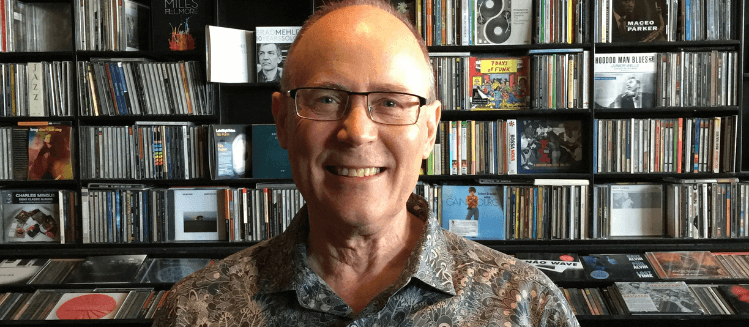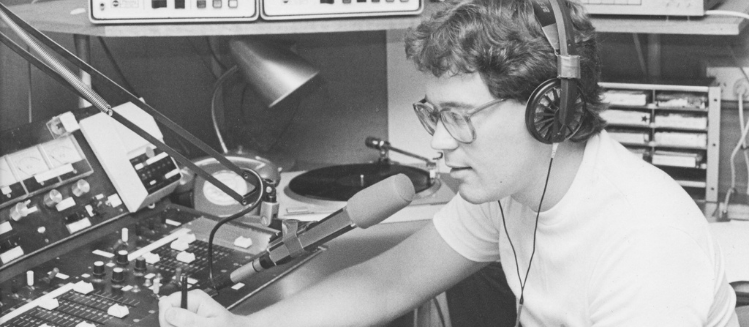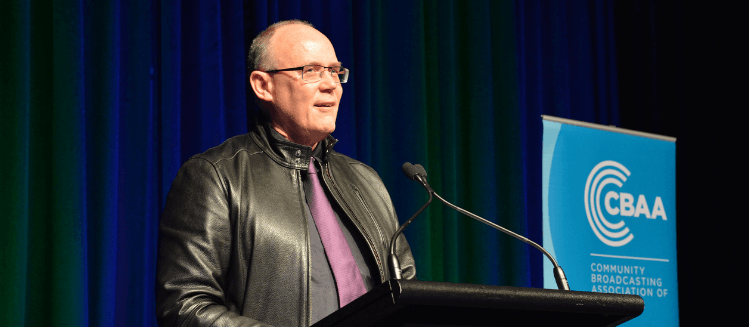
Ian Stanistreet was the perennial 1970s inner-city student living on muesli and beer with aspirations to becoming a lawyer when he discovered community radio and PBS FM. He never looked back.
In July 2020, Ian retired as CEO of the Community Broadcasting Foundation after 20 years at its helm.
We spoke to him recently about his life’s work and passion for community broadcasting.
What’s your story?
I’m a child of the 50s and 60s – an idealist, humanist and boomer.
I grew up in the Melbourne bayside suburb of Elwood as the middle child in a close-knit family, with an older and younger sister. My dad was a clerk of courts and my mother a nurse. When I was 11 we moved to Sale in East Gippsland where my father was appointed as a Stipendiary Magistrate.
Sale wasn’t your average country town in those days as the oil and gas industry had arrived bringing in workers and their families from all over the world. But it was still a small town surrounded by farmland with a population of only 8,000, and an RAAF base on its outskirts.
My first paid job at 16 was hay baling. I only lasted a day and have had great respect for farmers ever since. My second job was when I was a long-haired 18-year old uni student looking for work over the summer break. I found work as a trades assistant on the Marlin offshore oil platform in Bass Strait. It was a great experience (commuting by helicopter for each six-day shift was my favourite part) and seriously well-paid for unskilled labour, financing my first real stereo system and a lot of treasured vinyl.
For most of the 70s, I was a ‘professional’ student except for two years spent in the public service (as an assessor in the ATO. Yikes!). A simple twist of fate (that’s another story) saved me from becoming a suburban solicitor and led me to the community broadcasting sector.
How did you get involved in community broadcasting?
In 1980 I was an Arts–Law student at Melbourne University, a passionate collector of music on vinyl, and a regular ‘pub-rocker’ attending gigs by local bands across inner Melbourne. Being a serious music nerd got me a part-time job at the Rowden-White Library in the Student Union building playing records and handing out headphones to fellow music lovers. My wages were largely spent on entry to gigs, beer, and a daily diet of muesli, fried rice, and curry.
FM was still a relatively new medium promising radio in glorious stereo and so I was a regular listener to this new radio band, ostensibly while studying. I came across a station near the end of the FM dial called 3PBS-FM. It featured a different genre of music every two hours (many of which were completely new to me), no commercials, and DJ’s who spoke in normal voices with great knowledge and love of the music they were putting to air. Music Nirvana – I was hooked! Around this time, I started volunteering at PBS presenting drivetime, jazz programs and music specials. Two years later, I was appointed as their first Station Manager.
Back then the station was located in five rooms at the end of a first-floor corridor at the Prince of Wales Hotel in St Kilda. This turned out to be an inspired location for a music station providing access to a licensed venue for gigs, benefit concerts and the live music recording that became an important part of the station’s operations. I vividly remember the monthly station meetings held in a function room behind one of the upstairs bars. Lots of passionate (well-lubricated) discussions about the station’s operation and its programming direction.

What makes community broadcasting so special?
It creates positive social outcomes on so many levels simultaneously!
It’s a relatively cheap but powerful communications medium that is owned by, operated for, and accessible to the community at large. Being ‘for purpose’ rather than ‘for profit’, the community broadcasting sector has a much broader range of content that can be presented in more flexible formats.
We can be innovative, experimental, and niche rather than mass-audience focused.
Community broadcasting stations are hubs of the communities they serve. They function as amplifiers for the messaging of community groups, local councils and businesses, supporting their activities and operations. They reinforce community identity, connect people, and create belonging. For those actively involved in their operation, stations offer the opportunity to learn new skills and gain experience in so many areas – program production and presentation, interviewing, administration, promotion, and governance, to name just a few.
Over the many years of my involvement with community broadcasting, I had the privilege of seeing those connections being made and positive outcomes forged within and across communities in a myriad of ways, each and every day.
How has the community broadcasting sector changed over the years?
Since I first got involved it has grown enormously. Back in 1980, there were less than 50 community radio stations. Now there are over 450 services broadcasting to an audience of almost six million people across the country. In the 90s radio was joined by community television, and now both are developing a strong online presence.
What are some of the challenges facing the sector now?
Survival and rebuilding after the COVID-19 pandemic are top of the ‘challenges agenda’. It’s going to be important to learn from our pandemic experience and focus on building greater resilience across the sector so that we are able to withstand sudden pervasive changes that impact the way we operate.
Regulatory overhaul for all broadcasting is also way overdue with the Broadcasting Service Act 1992 pre-dating the digital revolution and increasingly out-dated. I believe this is particularly important for community television (CTV) which is being forced off the broadcasting spectrum and into an online-only future. Retaining its local free-to-air broadcast base while developing content access and longevity through online offers CTV its best chance to survive and prosper.
What about opportunities?
While the pandemic has been corrosive for community broadcasting in so many ways, it has also highlighted our value as a community builder and antidote to social isolation. Similarly, the sector’s role supporting so many communities through the Black Summer of 2019/20 highlighted our value providing vital hyper-local information during emergencies.
These experiences provide an opportunity to build a case for stronger financial and policy support at both Federal and state government levels, as well as to foster stronger mutually beneficial relationships with the philanthropic and corporate sectors.
Community broadcasting has functioned on minimal resource levels compared to other media for over 50 years. It has always punched way above its weight, but it could achieve much more for Australian society with a more adequate and appropriate level of resources.
While the digital revolution will roll on, in my view it presents great opportunities and challenges. NFP broadcasters are to a degree less vulnerable to its disruptions than our commercial brethren. Like it or not, we now live in a world where the individual curates their own information and entertainment on a 24/7 basis.
Fixed programming schedules and fixed receivers are of little importance when you carry a voice-controlled, AI-facilitated device in your pocket. ‘Online’ challenges the immediacy of radio but also solves its ephemerality.
Broadcasting remains our core heritage platform but there is much to be gained for locally-focused NFP broadcasters from streaming, content on demand, and the opportunity to publish audio, video, and text in any combination.
What do you hope to see happen in the next ten years?
I’d like to see the community broadcasting sector more appropriately recognised for its social value. This is a key step that would facilitate a better understanding of the sector as a social movement, with a unifying set of values, common goals, and a rich history.
In recent years, the Sector Roundtable, under the aegis of the Community Broadcasting Association of Australia, has done some good work articulating community broadcasting’s goals and values.
There is still more to do to ensure the purpose and value of community broadcasting is better understood both within the sector and in the general community. We need to tell our story more effectively.
Does the CBF still have a role to play?
I’ve always thought of the CBF as another expression of community broadcasting’s core values – independence, access, integrity, volunteerism.
As the steward of government funding-support for community broadcasting, it is often regarded as a kind of ‘sector bank’. But its grant-making role, while central, is just one dimension of its activities.
It also plays an important role as an initiator of strategic action. In the early 2000s the CBF ran programs distributing computers directly to stations to facilitate the take-up of email, website development and the adoption of other industry-related software. More recently, it facilitated the development and delivery of online trauma support for community broadcasters caught up in the Black Summer bushfires.
It may sound cliched to describe the CBF as a family but those closely involved know there is truth in the description, even more so now with the involvement of so many experienced broadcasters contributing their time and expertise as CBF Grant Assessors.
It’s also a work in progress, that continues to adapt its role as the environment changes. I reckon that Ian Hamm, Jo Curtin, and the rest of the CBF team have the measure of that ongoing challenge. I look forward to seeing it happen.
What is your proudest achievement during the time you’ve been at the CBF?
The establishment of the Community Media Training Organisation which we set up as an independent organisation in 2010 to provide training services for community broadcasters.
It has been kicking goals ever since. When I see the great work that they are doing it really makes me proud that I had some part in getting the organisation off the ground.
If there was one person you could nominate as having the greatest impact on community broadcasting, who would that be?
In terms of sector pioneers, it would have to be Michael Law who is regarded as the father of Australian Community broadcasting and was the CBAA’s first Executive Director. I was also fortunate to work closely for many years with a man who has made an outstanding contribution to community broadcasting over decades.
John Martin became involved in media as the coordinator of City Video (later Metro TV) Sydney’s first video-access centre – a forerunner of community television. In the late 1970s he became the first station manager of 2MCE-FM in Bathurst. Among his many other achievements, he established one of the first examples of RPH broadcasting with a talking newspaper program. He was also President of both the Community Broadcasting Association of Australia and the CBF.
John was a mentor and a friend. I remain in awe of his intellect and ability but mostly of his passion and enthusiasm for the community broadcasting. He was a community broadcasting pioneer and remains a sector stalwart. I have no doubt that John Martin is among those few who have had the greatest impact on the development of Australian community broadcasting.

We’ve talked about people, what about your favourite community radio show?
I have so many! Two unmissable music programs are The Afterglow presented by Lyndelle Wilkinson from 5pm Wednesdays on PBS and Breaking and Entering presented by Simon Winkler and Lauren Taylor from 4pm on Thursdays on 3RRR. CBF alumni Claire Stuchbery’s Firewater on Tuesdays from 5pm on PBS is my number three with a bullet!
Why? Passionate and knowledgeable presenters, great mix of music, many new artists featured as well as some more familiar ones. Just a pleasure to listen.
Looking back on 40 years in community broadcasting, what impact did it have on your life?
It completely changed my life!
In 1980, I segued straight from student life into community broadcasting and never left. The next 40 years certainly had their measure of struggle and adversity, but it was always outweighed by the joy of working for good with like-minded people. So many great people, so many colourful characters!
Over all those years, the most important lesson I learned about community broadcasting is that it’s not about technology, it’s about people. Supporting how they, as individuals and communities, communicate and relate to each other.
Working in community broadcasting gave me the purpose in life that I had been seeking. It literally got me out of bed every morning.
What’s next for you?
I decided to retire early this year for family reasons.
The pandemic wasn’t factored into my plans, so I’ve had to adjust many of my expectations about what’s next and affordable. Travel is off the agenda for the moment, but still features in the bucket list.
I’m enjoying more time for music, books and video under the lockdown and have been cultivating gardening skills (the butternut pumpkin harvest was enormous and I have a huge ‘cut and come again’ chard plant that is now taller than our back fence). I’m a planner by nature so there’s always a project, or three, on the go.
I’m focussed on family for the immediate future but once the new COVID-normal is achieved and we are ‘let loose’ I hope to come back to community broadcasting as a volunteer. It’s a life-long interest and passion for me and I like the idea of continuity and ‘closing the circle’ as a volunteer.
This is part of our new series of in-depth interviews with community broadcasting trailblazers and others who have made a lasting contribution to community media.
Photos: Ian Stanistreet at Ballarat’s Black Swan Records (top), on air at PBS (middle), and accepting the Michael Law Award in 2017 for his for outstanding contribution to community broadcasting (bottom)
